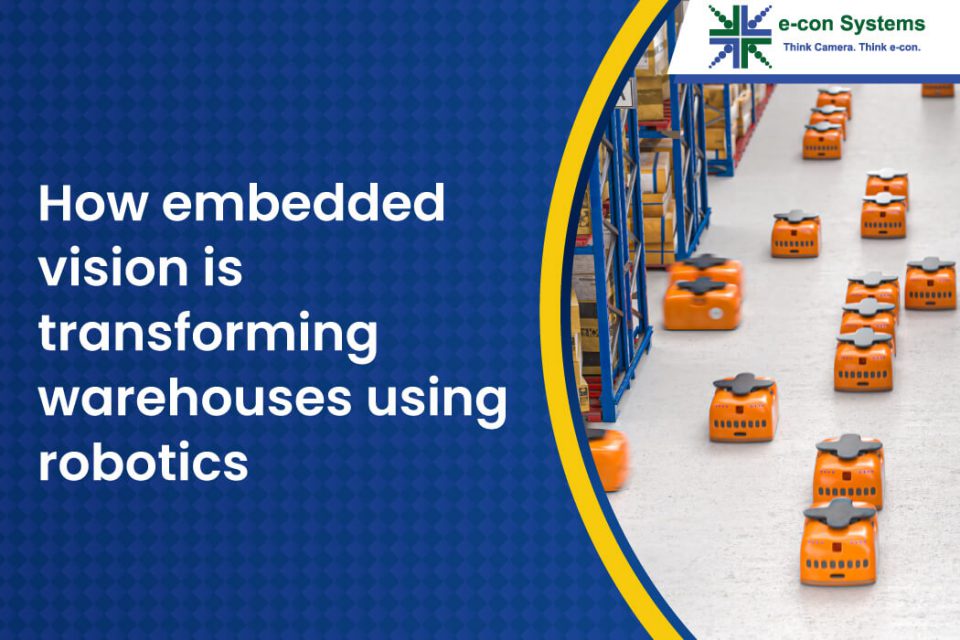Modern warehouses thrive on automation to accomplish key tasks such as material handling, quality inspection, conveyor monitoring, inventory tracking, etc. And they depend a lot on AMRs (Autonomous Mobile Robots) to do these with ease and with close to zero human supervision. This is a perfect example of human-machine collaboration where humans and robots work side by side to improve the productivity of warehouses.
These AMRs leverage embedded vision to help them see for the purposes of detecting obstacles, enabling surround-view, identifying objects, reading barcodes, and more. In this article, we do a deep dive into how cameras and embedded vision play a part in enhancing warehouse operations by helping AMRs perceive their environments.
Various types of AMRs used in warehouses
AMRs are autonomous vehicles that can augment (or completely replace) human labor, especially in warehouses. The different types of autonomous mobile robots used in warehouses are:
- Goods-to-person robots
- Pick and place robots and robotic arms
- Automated forklifts
- Inventory tracking robots and drones
- Cleaning/disinfection robots
- Delivery robots
Now that we briefly understand the different types of robots and where they are used, let us learn how cameras enable them with vision capabilities to automate various tasks in warehouses.
How cameras help transform warehouse operations using robots
The shortage of labor has led to warehouse owners automating many tasks, and robots have played a key role in this by positively impacting material loading and unloading, goods transportation, picking and placing items, etc. Let us learn more about this through the lens of different types of robots and autonomous vehicles used in warehouses.
Goods-to-person robots
In 2012, Amazon acquired Kiva Systems for a whopping $775M. Wonder why?
Kiva systems produced state-of-the-art goods-to-person robots that could transport warehouse shelves from one place to the other. This helped improve productivity by up to 2 to 3 times. These robots are also said to have reduced Amazon’s fulfillment costs by up to 40% (source: Tech Vision).
These intelligent robots can take goods from the point of delivery to warehouse racks where a human picker (or a pick and place robot in some cases) places the objects in the designated position on the shelf. They come in different variants such as the below:
- As a companion robot that travels with the human picker autonomously to carry objects.
- A robot that travels to the human picker with the objects from the point of delivery completely autonomously.
Now, where do cameras come in?
The major function of cameras in a goods-to-person robot is to help it navigate autonomously. This involves mapping (creating a geo map of the warehouse), localization (a robot locating its own position), navigating/path planning (moving from point A to point B), and obstacle detection & avoidance. This requires the robot to use a depth camera such as a 2D/3D LiDAR camera, a time of flight camera, or a stereo camera. A depth camera captures images and videos to measure depth to nearby objects enabling the robot to safely move around.
Pick and place robots and robotic arms
Picking robots are used at the point of shelf picking in warehouses where the robot has to pick objects from the shelf and place it in the carrying container and vice versa. These robots typically have arms that can hold objects stored on warehouse shelves. Cameras in these robots help to locate the exact position of the object on the shelf by using depth cameras. They also help to place the object in the desired location (either in the container or the shelf).
In addition, pick and place robots can also be used in warehouses for picking objects from conveyor belts and placing them in a container. Depending on the functionality, these robots might need to have object recognition capability, especially if it is used for any sorting purposes. In such a case, cameras also help to capture images for the computer vision algorithm to identify and classify objects.
Automated forklifts
Automated forklifts are also a type of AMRs that help carry heavy loads across a warehouse. They can perform this function without the help of a human in addition to having the capability of navigating autonomously. In these heavy vehicles, embedded cameras are used for all navigational functions such as mapping, localizing, path planning, and obstacle avoidance.
Unlike many other AMRs used in warehouses, automated forklifts will also have to automatically measure the dimensions of the objects/pallets they have to lift in order to adjust their forks accordingly. Cameras come to the rescue here as well. 3D depth cameras can facilitate automated dimensioning without any human involvement.
Inventory tracking robots and drones
As the term suggests, inventory tracking robots and drones help to regularly track and analyze warehouse stock. Cameras help these autonomous vehicles ‘see’ for:
- Stock detection and on-shelf availability mapping
- Inventory tracking for compliance
- Validating stock placement
- Checking for pricing and label issues
Here, cameras help in navigation as well as object identification. While navigation is done with the help of depth cameras, object identification is done either by means of barcode/RFID tag reading or image analysis with the help of computer vision. The latter is more complex and requires the camera system to be able to deliver accurate images for the algorithm to identify objects without any error.
Cleaning or disinfection robots
Cleaning or disinfection robots are used in warehouses and other environments to automatically clean objects and surfaces to destroy harmful germs and pathogens, especially from areas that humans are exposed to or are in contact with.
In these robots, cameras help in autonomous navigation, detecting dirt & pathogens, and locating the position of the surface to be cleaned by measuring depth. These self-driving robots may use a combination of 3D depth cameras, rolling shutter cameras, and global shutter cameras to perform these tasks.
Delivery robots
AMRs are used where objects have to be transported from warehouses to distribution and fulfillment centers, or from distribution centers directly to the consumer’s doorstep. The former is called middle-mile delivery and the latter is called last-mile delivery. In both scenarios, a warehouse or s distribution hub is involved. In such types of robots, cameras are used for:
- Autonomous navigation – helping the robot navigate safely.
- Package tracking – tracking the packages to be delivered.
- Surveillance – this is typically enabled in multi-purpose delivery robots where surveillance is an added feature.
e-con Systems’ camera solutions for autonomous mobile robots
e-con Systems has been integrating camera modules into autonomous mobile robots for many years – especially warehouse robots. We have worked with multiple customers to offer off-the-shelf cameras as well as customized solutions for different types of warehouse robots including goods-to-person robots, cleaning/disinfection robots, pick and place robots, etc.
To learn more about e-con’s camera solutions for AMRs, please visit the camera for autonomous mobile robots page. You could also visit the Camera Selector to have a look at our complete portfolio of cameras by features. Meanwhile, if you are looking for help in integrating cameras into your AMRs, please write to us at camerasolutions@e-consystems.com.
Customer Testimonial: Minus Zero’s zPod – the revolutionary autonomous vehicle features e-con’s GMSL2 HDR NVIDIA Jetson AGX Orin camera
e-con Systems is delighted to share the heart warming customer testimonial video from Minus Zero, one of our esteemed customers. They have generously appreciated our GMSL2 HDR NVIDIA Jetson AGX Orin camera – NileCAM21_CUOAGX used in their recently launched revolutionary zPod autonomous vehicle. We invite you to watch the video.

Gomathi Sankar is a camera expert with 15+ years of experience in embedded product design, camera solutioning, and product development. In e-con Systems, he has built numerous camera solutions for robots, industrial handhelds, quality inspection systems, smart city applications, industrial safety systems, and more. He has played an integral part in helping hundreds of customers build their dream products by integrating the right vision technology into them.




